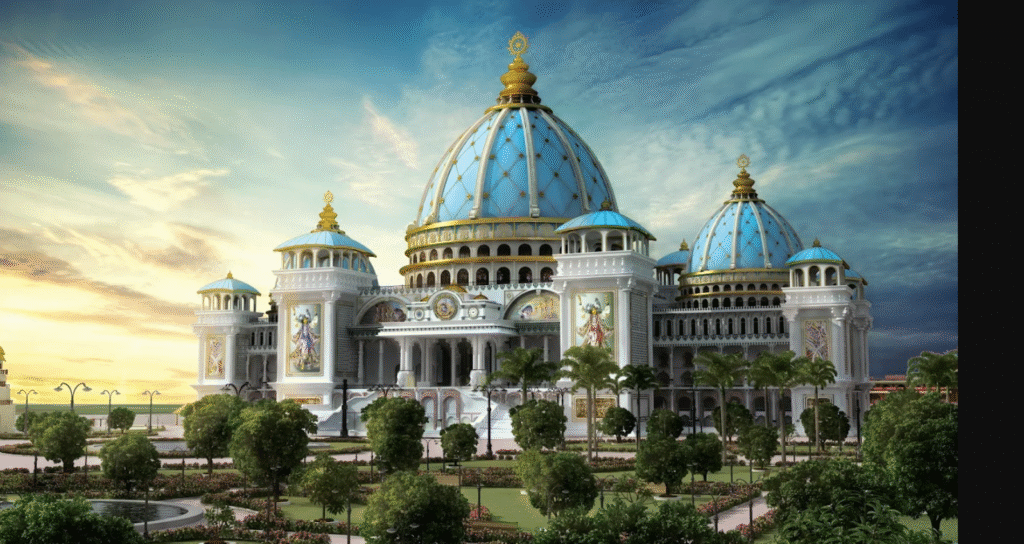
A temple in India holds a very special place in Hinduism, serving as a sacred space for worship, prayer, and spiritual connection. Hindu temples are beautifully designed with intricate carvings, sculptures of deities, and symbols that reflect deep religious traditions. They are not only places of devotion but also centers of culture, art, and learning. In India, temples often host vibrant festivals, rituals, and ceremonies that bring communities together. For Hindus, visiting a temple is considered an act of faith and purity, offering peace, strength, and guidance. Temples in India truly represent the heart of Hindu spirituality and heritage.
Top 10 largest temple by area
1) 1. Angkor Wat (Cambodia)
Angkor Wat, located near Siem Reap in Cambodia, is the world’s largest religious monument, spreading across 162 hectares. Built in the 12th century by King Suryavarman II, it was originally dedicated to Lord Vishnu and later became a revered Buddhist temple. Its magnificence lies in its vast scale, perfect symmetry, and breathtaking artistry. Surrounded by a massive moat and high stone walls, the temple symbolizes the cosmic Mount Meru, the center of the universe in Hindu and Buddhist belief. Its iconic five lotus-shaped towers rise majestically, representing the peaks of Mount Meru. The walls are adorned with over 3,000 intricate bas-reliefs and carvings, depicting celestial dancers (apsaras) and epic tales from the Ramayana and Mahabharata. Angkor Wat is not just a temple but a living symbol of devotion, power, and timeless beauty, making it one of humanity’s greatest architectural and spiritual achievements.
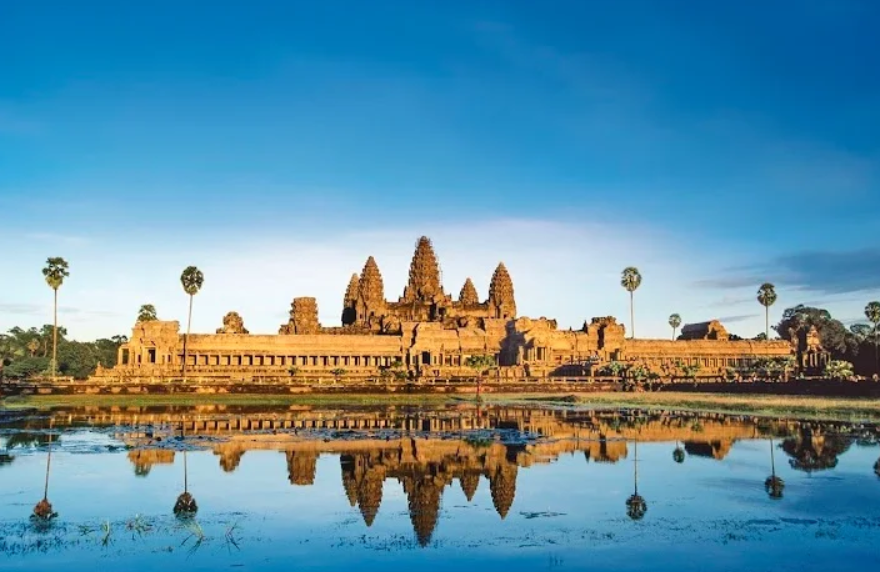
Angkor Wat (Cambodia)
2 ) Sri Ranganathaswamy Temple, Srirangam (India)
Sri Ranganathaswamy Temple, located in Srirangam, Tamil Nadu, India, is the second largest functioning Hindu temple complex in the world, covering about 156 acres. Dedicated to Lord Ranganatha, a reclining form of Vishnu, it is the foremost among the 108 Divya Desams, making it a sacred pilgrimage site for Vaishnavites. The temple is famous for its magnificent Rajagopuram, which rises 72 meters high and is the tallest temple tower in Asia. Its vast courtyards, intricately carved pillars, and sacred sanctums reflect both spiritual depth and architectural brilliance. Sri Ranganathaswamy Temple is a monument of devotion, heritage, and eternal grandeur.
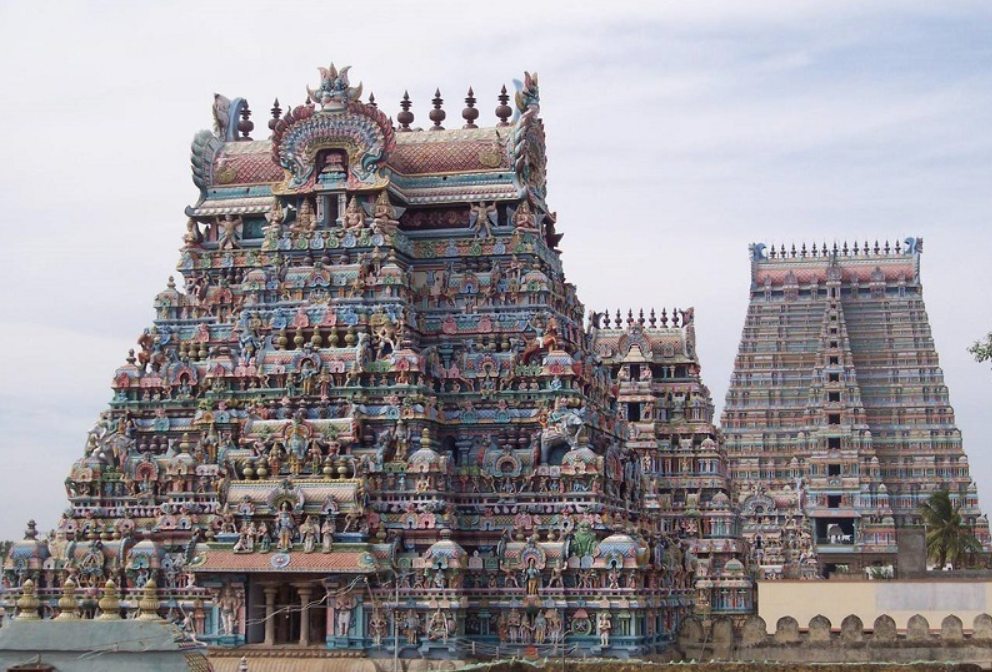
Sri Ranganathaswamy Temple, Srirangam (India)
3)Pashupatinath Temple (Nepal)
Pashupatinath Temple, located on the banks of the Bagmati River in Kathmandu, Nepal, is the third largest Hindu temple complex in the world and one of the most sacred shrines of Lord Shiva. A UNESCO World Heritage Site, it draws millions of pilgrims each year, especially during Maha Shivaratri. The temple is built in a traditional pagoda style, featuring gilded roofs, silver-plated doors, and exquisitely carved wooden rafters. At its heart lies the sacred Shiva lingam, radiating divine energy. Surrounded by countless smaller shrines, ashrams, and cremation ghats, Pashupatinath stands as a timeless symbol of devotion, heritage, and spiritual power.
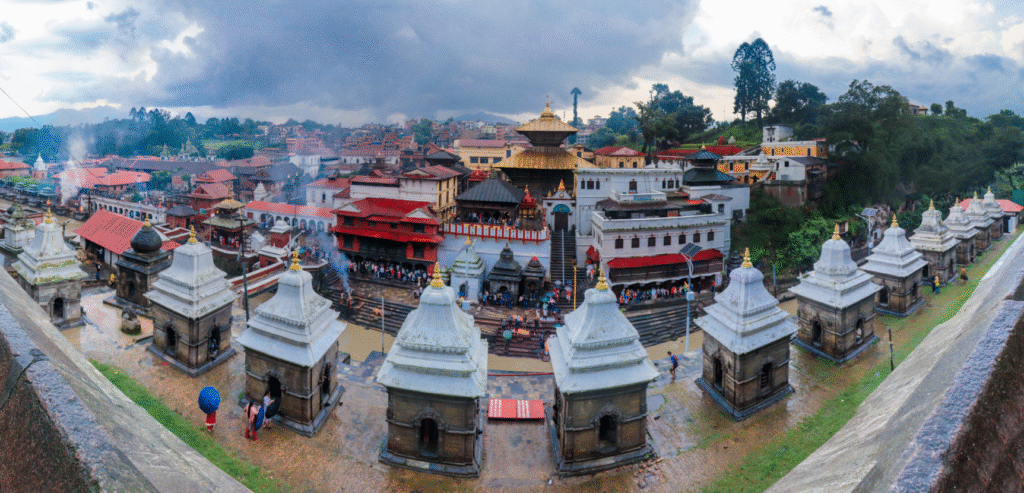
Pashupatinath Temple (Nepal)
4) Swaminarayan Akshardham (India)
Swaminarayan Akshardham in New Delhi, India, is a modern architectural marvel and one of the world’s largest Hindu temple complexes. Dedicated to Bhagwan Swaminarayan, it showcases the grandeur of Indian culture, spirituality, and craftsmanship. Opened in 2005, the temple features a majestic central monument built entirely of pink sandstone and white marble, adorned with over 20,000 intricately carved statues, pillars, and domes. Surrounding the temple are beautiful gardens, cultural exhibitions, and the mesmerizing Yagnapurush Kund, the world’s largest stepwell. The Sahaj Anand Water Show and spiritual boat ride further enrich the experience. Akshardham stands as a glorious symbol of faith, art, and timeless Indian heritage.
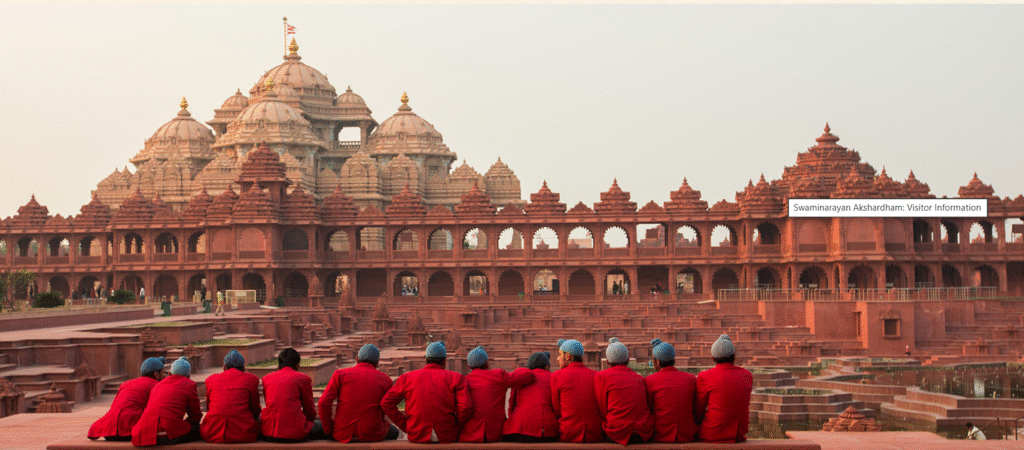
Swaminarayan Akshardham (India)
5) Chhatarpur Temple (Delhi, India)
Chhatarpur Temple, located in South Delhi, India, is one of the largest Hindu temple complexes in the world and a prominent center of devotion to Goddess Katyayani (a form of Durga). Spread across nearly 70 acres, the temple beautifully blends North and South Indian architectural styles, featuring grand marble structures, intricately carved pillars, and expansive courtyards. Built in 1974 by Baba Sant Nagpal Ji, the temple is especially vibrant during Navratri, when thousands of devotees gather for worship. With its vast area, serene environment, and spiritual aura, Chhatarpur Temple stands as a magnificent symbol of faith, devotion, and Indian architectural brilliance.
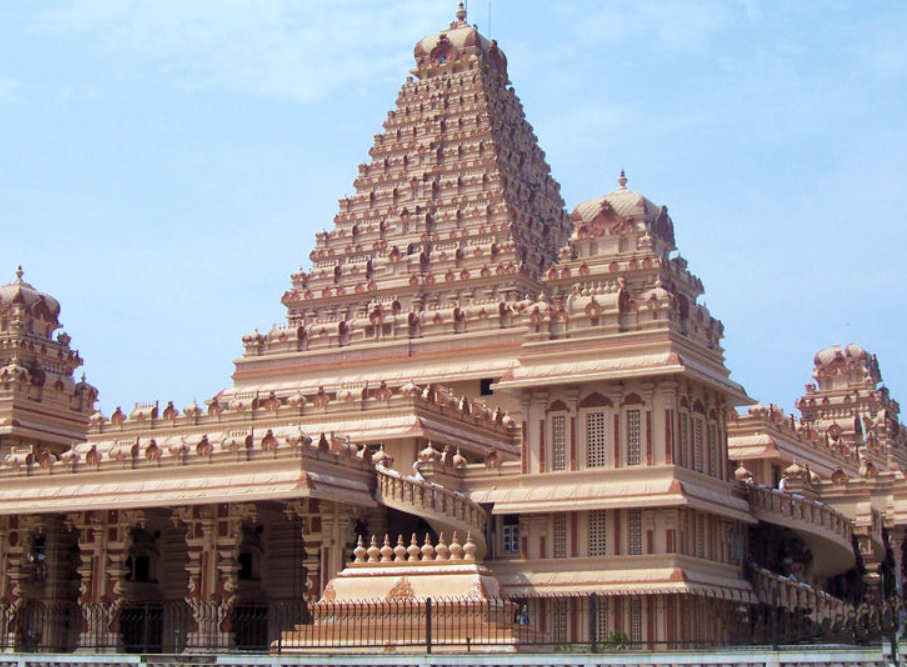
Chhatarpur Temple (Delhi, India)
6) Brihadisvara Temple, Thanjavur (India)
Brihadisvara Temple, located in Thanjavur, Tamil Nadu, India, is one of the greatest masterpieces of Chola architecture and a UNESCO World Heritage Site. Built by Raja Raja Chola I in the 11th century, it is dedicated to Lord Shiva and is also known as the “Big Temple.” The temple is renowned for its towering vimana (temple tower), which rises to about 66 meters, making it one of the tallest in the world. Constructed entirely of granite, the temple displays intricate sculptures, frescoes, and inscriptions that reflect the cultural and spiritual richness of the Chola dynasty. Its massive monolithic Nandi statue, detailed carvings, and precise architectural design symbolize both divine power and human genius. Brihadisvara Temple is not only a place of worship but also a living monument of India’s heritage, devotion, and artistic excellence.
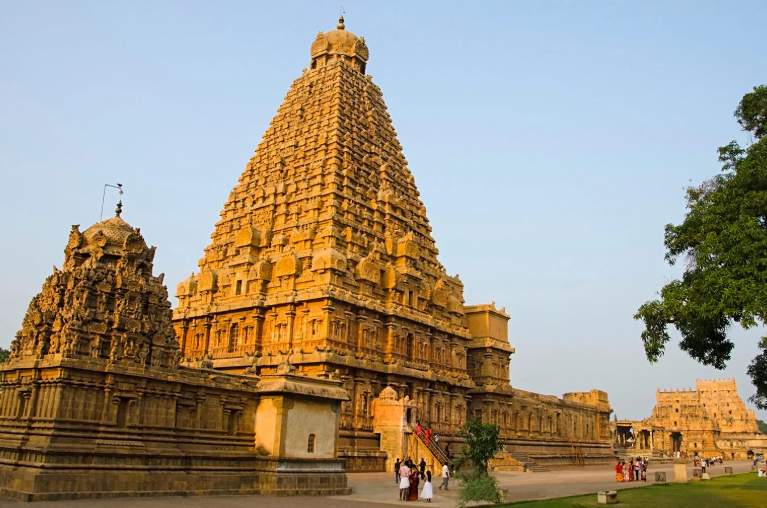
Brihadisvara Temple, Thanjavur (India)
7) Prem Mandir, Vrindavan (India)
Prem Mandir, located in Vrindavan, Uttar Pradesh, India, is a magnificent temple dedicated to Radha Krishna and Sita Ram. Inaugurated in 2012 by Jagadguru Kripalu Ji Maharaj, it is often called the “Temple of Divine Love.” Built entirely of white Italian marble, the temple shines brilliantly, especially under night lighting, showcasing its intricate carvings and breath-taking sculptures. The walls depict scenes from Krishna’s Leela’s, such as lifting Govardhan Hill and dancing with the gopis, bringing spiritual stories to life. Spread across 54 acres, the temple complex includes beautifully landscaped gardens, musical fountains, and illuminated tableaux. Prem Mandir stands as a dazzling symbol of devotion, love, and divine artistry.
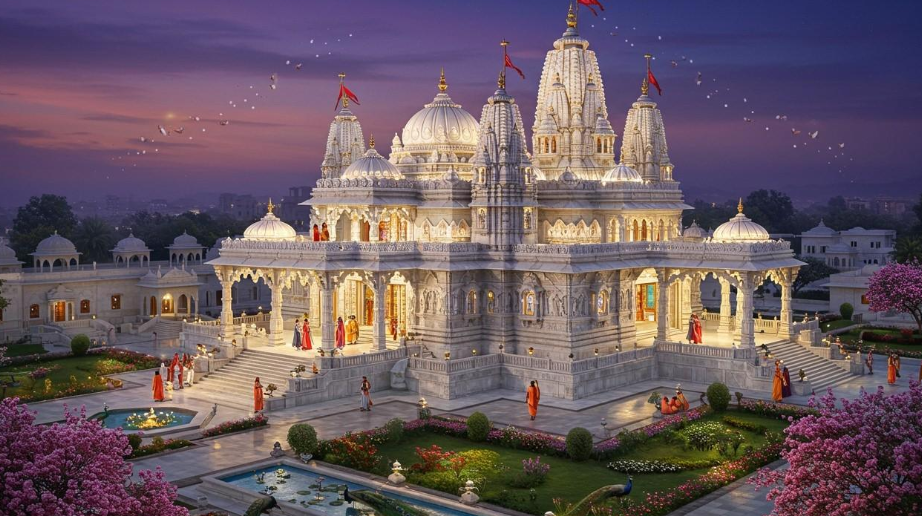
Prem Mandir, Vrindavan (India)
8)Ekambareswarar Temple, Kanchipuram
Ekambareswarar Temple, located in Kanchipuram, Tamil Nadu, India, is one of the largest and most revered temples dedicated to Lord Shiva. Spanning nearly 25 acres, it is a major part of the Panch Bhoota Stalas, representing the element of Earth (Prithvi Lingam). The temple is famed for its towering Rajagopuram, rising to about 59 meters, one of the tallest temple towers in South India. A unique feature is the 3,500-year-old mango tree within the temple complex, said to yield fruits of four different varieties, symbolizing the four Vedas. Originally built by the Pallavas and later expanded by the Cholas and Vijayanagara rulers, the temple showcases exquisite Dravidian architecture, with massive halls, intricate sculptures, and spacious courtyards. Ekambareswarar Temple stands as a timeless symbol of devotion, heritage, and architectural magnificence.
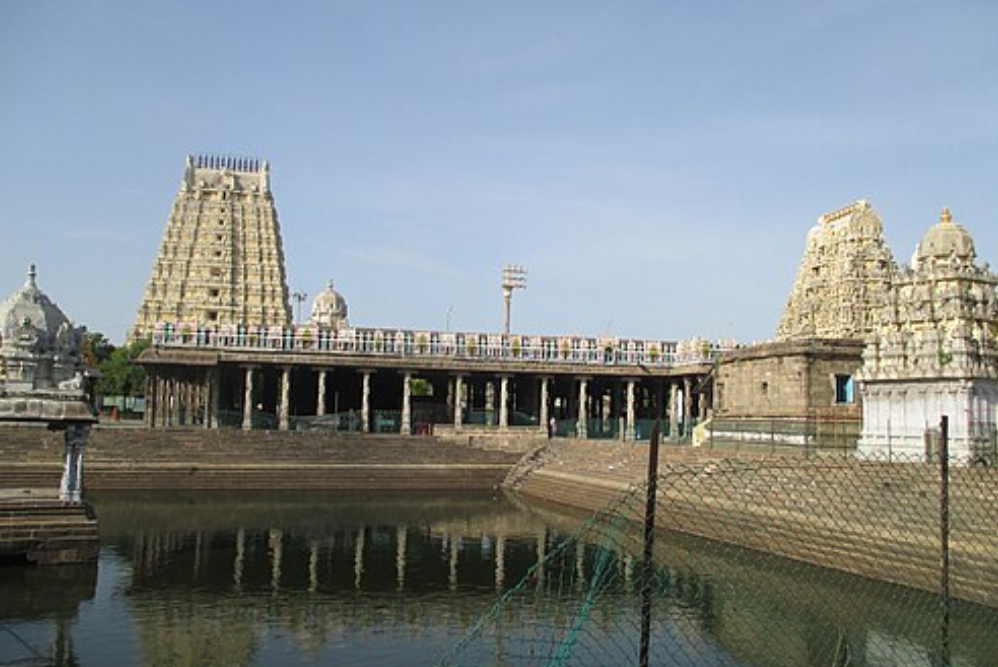
Ekambareswarar Temple, Kanchipuram
9)Thyagaraja Temple, Tiruvarur (India)
Thyagaraja Temple in Tiruvarur, Tamil Nadu, is one of India’s largest temple complexes, covering about 30 acres. Dedicated to Lord Shiva as Thyagaraja, it is a major center of Saivism and Chola-era architecture. The temple is world-famous for its massive wooden chariot (theru), the largest of its kind in Asia, used during the annual car festival that draws thousands of devotees. Its architectural features include towering gopurams, spacious mandapams, and intricate stone carvings that highlight Chola craftsmanship. Beyond religious importance, the temple is closely linked with classical Carnatic music, as Tiruvarur is the birthplace of Saint Thyagaraja. Rich in history, spirituality, and culture, the temple stands as a symbol of Tamil Nadu’s architectural and devotional heritage.
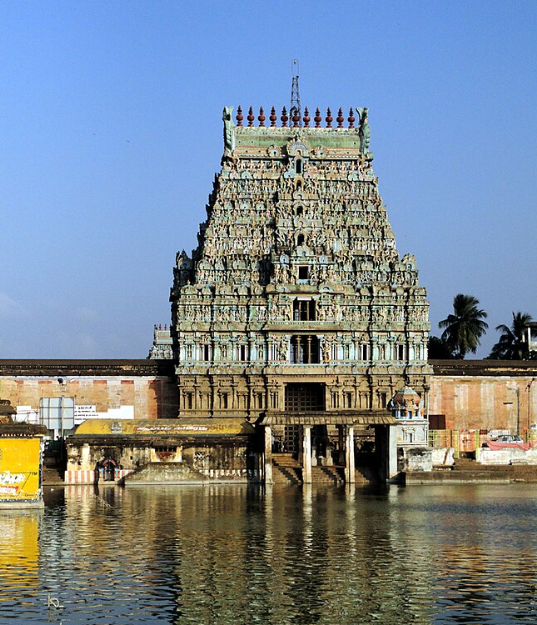
Thyagaraja Temple, Tiruvarur (India)
10)Arunachalesvara Temple,Tiruvannamalai
The Arunachalesvara Temple in Tiruvannamalai, Tamil Nadu, is a major Shiva temple representing the Agni (fire) element of the Pancha Bhoota Stalas. Spread across 25 acres, it is one of India’s largest temples, showcasing Dravidian architecture. The temple has four monumental gopurams, with the eastern Rajagopuram standing at 66 meters, among the tallest in Asia. Dedicated to Lord Shiva as Annamalaiyar, it attracts millions during the Karthigai Deepam festival, when a massive flame is lit atop Annamalai Hill. The temple’s grand halls, sacred tanks, and ancient carvings make it both a spiritual hub and a cultural treasure of Tamil Nadu.
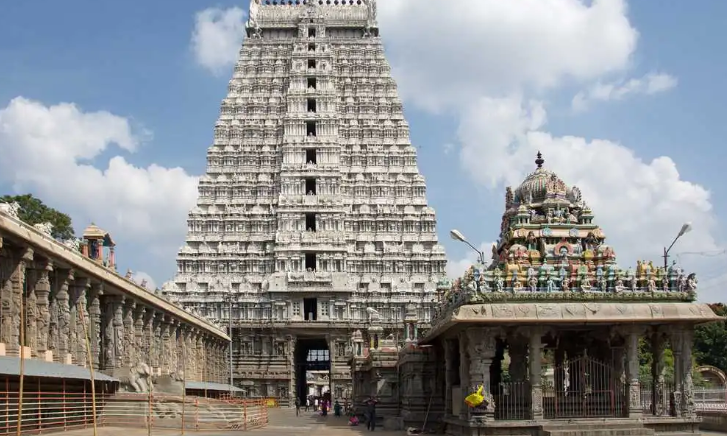
Arunachalesvara Temple,Tiruvannamalai (India)
The Mayapur Temple of the Vedic Planetarium, being built by ISKCON in West Bengal, India, is one of the most ambitious temple projects in the world. Once completed, it is expected to be among the largest temples globally, blending spiritual grandeur with modern architecture. The temple is designed to showcase Vedic cosmology through advanced exhibits, planetarium shows, and detailed depictions of ancient wisdom. With a capacity to hold tens of thousands of devotees, its grand dome is set to surpass many existing religious structures in scale. Though still under construction, Mayapur Temple is envisioned as a global spiritual hub.

Mayapur Temple of the Vedic Planetarium (Under Con.)
Leave a Reply